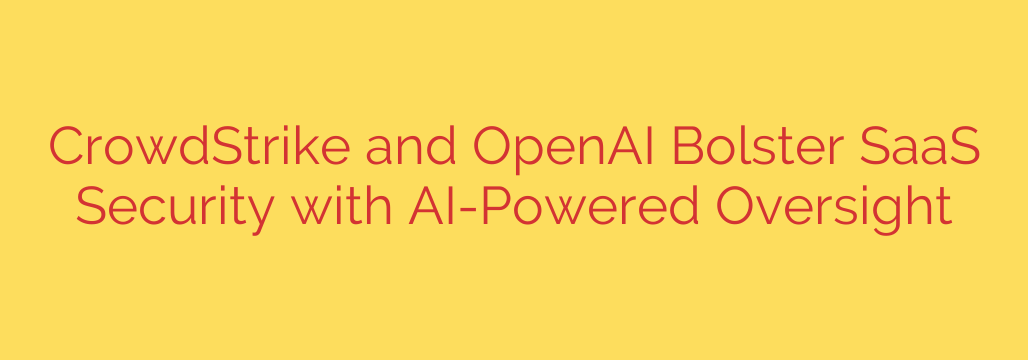
Taming the Digital Wild West: How AI is Reinventing SaaS Security
The modern business environment runs on Software-as-a-Service (SaaS) applications. From collaboration and project management to finance and marketing, these cloud-based tools are the engines of productivity. But this convenience comes with a hidden cost: a sprawling, often unmanaged, digital landscape that creates significant security risks.
As organizations adopt more and more apps, security teams are struggling to keep up. This rapid, uncontrolled growth—often called “SaaS sprawl”—leads to a dangerous phenomenon known as “shadow IT.” This is when employees use applications without official approval or oversight from the IT department, opening the door to data breaches, compliance violations, and unforeseen threats.
For years, the task of discovering and managing these applications has been a manual, time-consuming, and ultimately impossible challenge. But a powerful new approach is changing the game, leveraging the capabilities of artificial intelligence to bring order to the chaos.
The Core Challenge: You Can’t Secure What You Can’t See
The fundamental problem with SaaS sprawl is a lack of visibility. When your security team doesn’t know which applications are connected to your network, who is using them, or what data they can access, it’s impossible to build an effective defense.
This visibility gap creates several critical risks:
- Unsanctioned Data Access: Employees might grant an unknown application excessive permissions, inadvertently exposing sensitive company or customer data.
- Compliance Violations: Industries with strict data privacy regulations (like healthcare or finance) can face severe penalties if data is handled by non-compliant SaaS tools.
- Increased Attack Surface: Every unmanaged application is another potential entry point for attackers to exploit.
- Wasted Resources: Companies often pay for multiple applications with overlapping functionality, leading to inefficient spending.
Manually tracking every application is no longer feasible. The sheer volume and dynamic nature of SaaS usage demand a smarter, automated solution.
AI to the Rescue: Automating Discovery and Risk Assessment
Leading cybersecurity and AI platforms are now collaborating to tackle this problem head-on. By combining advanced endpoint security with the analytical power of large language models (LLMs), a new generation of security tools is emerging. This technology offers a transformative way to manage and secure your SaaS ecosystem.
Here’s how this AI-powered oversight works:
1. Comprehensive and Automated Discovery
Instead of relying on manual surveys or network logs, these systems can automatically identify every SaaS application being used across your organization. This includes discovering shadow IT applications that were previously invisible to security teams. By analyzing usage data in real-time, you get a complete and continuously updated inventory of your entire SaaS footprint.
2. Deep Insights into Usage and Permissions
Once an application is discovered, the AI gets to work analyzing how it’s being used. It can determine which employees are using which apps, how frequently they access them, and what level of permissions they have. This allows security teams to instantly spot risky behavior, such as a user with access to sensitive financial data through an unvetted third-party app.
3. Intelligent Risk Prioritization
Perhaps the most significant benefit is the ability to automatically assess and prioritize risk. The AI can analyze an application’s function, its data access, and its user base to assign a risk score. This empowers security teams to move from a reactive to a proactive posture, focusing their attention on the most critical threats first. Instead of treating all unmanaged apps equally, they can immediately address the ones that pose the greatest danger to the organization.
Actionable Steps to Strengthen Your SaaS Security
Adopting an AI-driven solution is a major step forward, but it should be part of a broader security strategy. Here are some actionable tips to help you regain control over your application environment:
- Establish a Clear SaaS Vetting Policy: Create a formal process for approving and onboarding new applications. Define security, compliance, and data handling requirements that any new tool must meet before it’s adopted.
- Embrace a Zero Trust Mindset: Operate on the principle of “never trust, always verify.” This means granting applications and users the minimum level of access necessary for their roles (the principle of least privilege) and continuously verifying their legitimacy.
- Educate Your Employees: Often, shadow IT arises from a desire to be more productive, not from malicious intent. Train your team on the security risks of using unapproved software and show them how to follow the official vetting process.
- Leverage Automated Security Tools: The scale of modern SaaS usage makes manual management impossible. Invest in solutions that provide automated discovery, monitoring, and risk assessment. This frees up your security team to focus on strategic initiatives rather than endless administrative tasks.
The age of SaaS sprawl requires a new security paradigm. By harnessing the power of artificial intelligence, organizations can finally illuminate the shadows of their IT environment, transforming a critical vulnerability into a well-managed and secure asset.
Source: https://datacenternews.asia/story/crowdstrike-openai-enhance-saas-security-with-ai-agent-oversight








